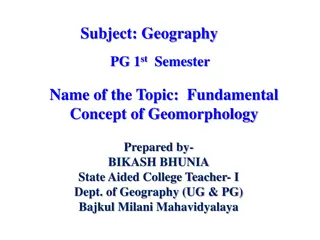Understanding Earth's Atmosphere: A Detailed Overview
The Earth's atmosphere is a vital layer of gases that encircles our planet, providing the necessary conditions for life to thrive. It consists of several distinct layers, each with unique characteristics and functions. From the troposphere closest to the surface to the thermosphere extending to great heights, this comprehensive guide delves into the composition, structure, and significance of each atmospheric layer. Explore the role of the ozone layer, the effects of temperature variation, and intriguing phenomena like auroras as we unravel the mysteries of our atmospheric realm.
Download Presentation

Please find below an Image/Link to download the presentation.
The content on the website is provided AS IS for your information and personal use only. It may not be sold, licensed, or shared on other websites without obtaining consent from the author. Download presentation by click this link. If you encounter any issues during the download, it is possible that the publisher has removed the file from their server.
E N D
Presentation Transcript
ATMOSPHERE DR. SHAKHA SHARDA
INTRODUCTION Layer of gases surrounding the Earth Held due to gravitational pull Height of atmosphere from sea level is 1600 km Derived from Greek word atmos means vapour Composition of atmosphere major : water vapours (most variable component) N; 78% (largest proportion) and O2; 21% minor : Ar; 0.9, CO2; 0.03% trace : Ne, He, Xe, Rn etc.
Structure of Atmosphere (Sutcliffe : 1966)
STRUCTUREOF ATMOSPHERE Troposphere lowest layer (layer closest to man) Greek word: tropos; mixing distance: 8 kms from poles; 18kms from equator temperature decreases with increasing altitude (+lapse rate) turbulent region, climate changes, cloud formation, regulates weather, lightening, thundering , sound transmission twilight of dusk and dawn, medium of flight pollination of seeds, fruits, seeds and spores Circulation of biogeochemical cycles(CO2, O2, H2O, N) Tropopause: transition zone between troposphere and stratosphere, winds move in horizontal direction (jet streams: 480kms/hr)
CONTD--- Stratosphere second layer: 16-55 kms ozone layer: 25 km from mean sea level (protects from radiations) temperature increases with height (negative lapse rate) no mixing: free of clouds long distant flights Stratopause: boundary between stratosphere and mesosphere harmful UV
CONTD--- Mesosphere 55-80 kms :middle atmosphere temperature decreases with height meteors burns up coldest layer Mesopause: boundary between mesosphere and thermosphere
CONTD--- Thermosphere 80-500 kms. temperature increases with height telecommunication services phenomenon of Auroras ( colorful light display which can be seen almost every night by people near poles) o Exosphere Up to infinity
CONTD--- Study stratosphere Meteorology. Study thermosphere is called Aerology Atmospheric pressure: Barometer Temperature : Thermometer Wind : Anemometer Atmospheric humidity: paper strip hygrometer of troposphere is and called of mesosphere and
AIRPOLLUTION WHO (World Health Organization) the presence of materials in air in such concentration which are harmful to man and environment is known as air pollution. Sources Natural: e.g. Volcanic eruptions, forest fires Man-made: e.g.combustion, industrial processes, agricultural activities, household activities
TYPESOFAIRPOLLUTANTS Primary pollutants remain as such in air : CO,NO, SO2, HC, CO2, NO2, SPM and CFC Secondary pollutants formed due to chemical reactions among primary pollutants : ozone, smog, acid rain
14 out of 20 most polluted cities of the world are in India and four out of these are in Punjab. NCR the most polluted region of the world where during smog each one inhales toxins equal to 30 cigarettes a day
OXIDESOFCARBON CO: incomplete combustion hypoxia : O deficiency anoxia : CO poisoning CO2: complete burning ocean acidification green house effect: CO2, CH4 N2Oand CFC s (Green House Gases) global warming
OXIDESOF SO2 Cause acid rain Leads to chlorosis (yellowing of leaves) and necrosis ( death of tissues) Discoloration of buildings Irritation in eyes Asthma Kills fishes Mutagenic properties
OXIDESOF NO2 Photochemical smog PAN (Peroxy Acyl Nitrate) Acid rain Corrosion of metals Fading of textiles Necrosis, defoliation Eye irritation, congestion Injury to lungs, liver and kidneys lung odema, blood
SPM (SUSPENDED PARTICULATE MATTER) Cotton dust : Bysinosis/ Pneumoconiosis Stone grinding : Silicosis Iron mills : Siderosis Pollen grains : Hay fever Others: VOC s ( Volatile Organic Compounds) : benzene, toluene, xylene Carcinogenic Leukemia
SECONDARY POLLUTANTS Acid rain ( Nitric acid and Sulphuric Acid) term coined by Robert Angus Smith, 1872 pH less than 5.4 (Acid Rain) West Virginia, Washington D.C. : pH 1.2 Taj Mahal (India) Dead lakes (Norway, Sweden, Germany, U.S.A.) Stone leprosy
PHOTOCHEMICAL SMOG (FOG+SMOKE) 1946 (Los Angeles, U.S.A.) Brown haze Automobiles exhaust NO2 PAN (Peroxy Acyl Nitrate)
REDUCING SMOG/ CLASSICALSMOG 1952 (London) Blackish grey Burning of coal SO2 Killed 4000 people in London
OZONE HOLE/ DEPLETIONOF OZONE LAYER Thinning of ozone layer (Farman et al, 1985) Formed by the interaction of sunlight with NOx (oxides of Nitrogen) and VOC s (Volatile Organic Compounds) Maximum thinning of ozone layer is during spring season The thickness of ozone is measured in Dobson Unit (DU); 1DU = 1ppb Major hole was seen over Antarctica (South Pole) and minor hole over Greenland (North Pole); September 2003.
CASESTUDIES Bhopal Gas Tragedy, 3rd Dec, 1984 MiC (Methyl Isocyanate) and Phosgene Chernobyl Nuclear Disaster, 1986;USSR Sevoso Episode, 1976;Italy Three Mile Island Nuclear Disaster, 1979; U.S.A Hiroshima and Nagasaki (1945) during World War II
Three mile island Bhopal Gas tragedy
CONTROL OF AIR POLLUTION Control of Particulate Emissions Gravity settlers: settling of SPM with force of gravity Cyclone Separators: separation of particulates through centrifugal motion from a gas stream Impinger: consists of bubble tubes for collecting particulates into a liquid medium Wet Scrubbers: collecting the particulates in a scrubbing liquid Electrostatic Precipitator (ESP): use an electrostatic field o induce a charge on particulates to remove them Bag Filters: large sized porous bags for filtering the particulates under pressure.
CONTROLOF AIR POLLUTION Control of Gaseous /Industrial Emissions Tall Chimneys Absorption(within the surface) Adsorption (on the surface) Condensers Desulphurization Raprenox (Rapid Removal of NOX ) Catalytic Converters Incinerators Control of Vehicular Emissions Catalytic converters Unleaded petrol Use of CNG Biodiesel (Jatropa)























